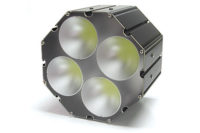
The Philips EnduraLED 800 A19 with 800 lumens is a replacement for a standard 60 watt incandescent light bulb. It requires 12.5 watts of power. Source: Philips
LEDs, or Light Emitting Diodes, are light-emitting semiconductor devices. They use electronic properties of semiconductors to convert electricity to light rather than thermal emission as do incandescent light bulbs. LEDs, which are diodes, use control electronics since they have non-linear responses to changes in applied voltage.
LEDs, which are diodes, use control electronics since they have non-linear responses to changes in applied voltage.
LED development, in some ways, is similar to the development of semiconductor transistors. Work on the original transistor at Bell Laboratories was motivated by wanting to replace the heated elements in the electronic vacuum tube amplifiers with amplifiers that did not require significant heating to function.
The rate of LED improvements is similar to the rate of improvements of silicon-based electronic devices. Light output per LED has doubled about every two years since 1970 (Haitz’s Law), reminiscent of Moore’s Law for doubling of the number of transistors (on an integrated circuit) about every eighteen months.
The continuing improvements in efficiency, maximum optical power and long life have also translated into more applications, larger production volumes and expanding markets.
To see the increasing use of LEDs, just look around. They can be seen as illumination in mobile phones, LCD flat screen television displays, computers, cameras, automobile lights and traffic lights. This pattern drives continuing efforts to improve performance, reduce costs and further expand applications.

The Cree CR6, in a 6 inch recessed housing, is a replacement for a 60 watt incandescent bulb. It provides 575 lumens at 120 volts (10.5 watts) and is dimmable. Source: Cree
LED Features
LED lighting has advantages over incandescent and other lighting:Cool. LEDs are cool-literally and figuratively. They require 5 to 10 times less electrical power to provide the light output equivalent to a 60 watt incandescent light bulb.
Long life and low ongoing maintenance costs. As with most semiconductor devices, LEDs have a long lifetime, typically about 25,000 average life with some specifications reported up to 50,000 hours. Incandescent lamps of 40 Watts have typically 1,000 hours. Fluorescent lamps of 17 to 36 watts are rated from about 3,000 hours to 8,000 hours. It has been noted that if you install LED lighting in a new home, you will probably still have most, if not all, of the installed lighting when you sell it.
Rapid switching capability. LEDs can be switched on/off in less than 1 microsecond. This opens opportunities/applications for short-range optical communications, eliminating shutters in fast cameras, automotive lighting, etc. More rapid switching-on of automobile stop lights can improve safety. The decrease in response time with LEDs (over incandescent bulbs) by one-half second permits stopping one car length earlier at usual highway speeds. Accident statistics appear to this claim.
Availability in many colors plus white in different geometries. LED units are commercially available that produce light from the ultraviolet to the near-infrared plus white. In particular, there are modules in the ultra-violet (at 395 nanometers (nm)), blue (470 nm), green (520 nm), yellow (590 nm), orange (625 nm), red (660 nm), infrared (880 nm) and white.
Small, flexible units. The units generally make effective use of space. When color and switching speed or space requirements are involved, then the LEDs also can replace other components. Again, this can simplify and reduce hardware, software and costs.
Top Applications of High-Brightness LEDs
The worldwide high-brightness LED (HB-LED) market for packaged devices jumped from $5.6 billion in 2009 to $10.8 billion in 2010 as reported in LEDs Magazine.Mobile applications led in 2010 with $4.2 billion (39% market share). This includes mobile phone displays, computers and tablets as well as portable DVDs and eBooks.
TV and monitor back-lighting of LCDs was second with $3.56 billion (33% market share).
The lighting market was about $900 million in 2010 with architectural and replacement bulbs accounting for over 50% of this market sector.
The largest growth expected in the next couple of years was reported to be in backlighting.
Architectural and replacement bulbs were projected to have significant growth after 2014 when initial costs are anticipated to be more competitive than for incandescent and fluorescent lamps.
